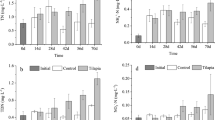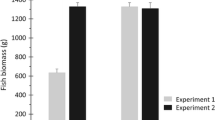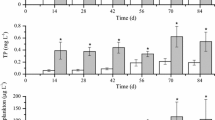Abstract
Effects of zooplankton refuge on the growth of tilapia (Oreochromis niloticus) and plankton dynamics in pond were assessed by using 12 land-based experimental enclosures (7 m× 4 m) in a saline–alkaline pond. There were 4 treatments resulting from a combination of 2 stocking densities of tilapia (5 and 10 kg per enclosure) and 2 enclosure types (refuge and nonrefuge). Each treatment had three replicates. In the enclosures with refuge, all fish were excluded from a water column ¼ of the enclosure’s size with a polyethylene net (1.5 cm mesh size). Our field experiment showed that the individual gain in weight of tilapia increased 6.4 times with refuge treatment at the stocking density of 5 kg per enclosure than that in nonrefuge treatment. But at the stocking density of 10 kg per enclosure, the individual fish weight in all enclosures decreased due to the excessive density of fish stocking. Our results also showed that the refuge significantly increased the rotifer biomass and phytoplankton diversity and decreased the phytoplankton biomass (P < 0.05), but the copepod biomass was not affected by the refuge.






Similar content being viewed by others
References
Boyd CE, Tucker CS (1998) Pond aquaculture water quality management. Kluwer, Boston
Burke JS, Bayne DR, Rea H (1986) Impact of silver and bighead carps on plankton communities of channel catfish pond. Aquaculture 55:59–68
Carpenter SR, Kitchell JF, Hodgson JR (1985) Cascading trophic interactions and lake productivity. Bioscience 35:634–639
Carpenter SR, Cottingham KL, Schindler DE (1992) Biotic feedbacks in lake phosphorus cycles. Trends Ecol Evol 7:332–336
Crowley PH (1973) Filtering rate inhibition of Daphnia pulex in Wintergreen lake water. Limnol Oceanogr 18:394–402
Datta S, Jana BB (1998) Control of bloom in a tropical lake: grazing efficiency of some herbivorous fishes. J Fish Biol 53:12–24
Diana JS, Dettweiler DJ, Lin CK (1991a) Effect of Nile tilapia (Oreochromis niloticus) on the ecosystem of aquaculture ponds, and its significance to the trophic cascade hypothesis. Can J Fish Aquat Sci 48:183–190
Diana JS, Lin CK, Schneeberger PJ (1991b) Relationships among nutrient inputs, water nutrient concentrations, primary production, and yield of Oreochromis niloticus in ponds. Aquaculture 92:323–341
Drenner RW, deNoyelles F Jr, Kettle D (1982) Selective impact of filter-feeding gizzard shad on zooplankton community structure. Limnol Oceanogr 27:965–968
Geiger JG (1983) A review of pond zooplankton production and fertilization for the culture of larval and fingerling striped bass. Aquaculture 35:353–369
Grover JJ, Olla BL, O’Brien M et al (1989) Food habits of Florida red tilapia fry in manured seawater pools in the Bahamas. Prog Fish-Cult 51:152–156
Huang XF, Chen WM, Cai QM (1995) Survey, observation and analysis of lake ecology. Standards Press of China, Bei**g (in Chinese)
Irvine K, Moss B, Balls H (1989) The loss of submerged plants with eutrophication II. Relationships between fish and zooplankton in a set of experimental ponds, and conclusions. Freshw Biol 22:89–107
Kajak Z, Rybak JI, Spodniewska I et al (1975) Influence of the planktivorous fish Hypophthalmichthys molitrix (Val.) on the plankton and benthos of the eutrophic lake. Pol Arch Hydrobiol 22:301–310
Li DS, Yang HS, Wang JQ et al (1998) A device of land-based experimental enclosure used ponds. Ocean Univ Qingdao J 28:199–204 (in Chinese with English abstract)
Lu KH, ** CH, Dong SL et al (2006) Feeding and control of blue-green algal bloom by tilapia (Oreochromis niloticus). Hydrobiologia 568:111–120
Martin JF, Izaguirre G, Waterstrat P (1991) Planktonic Oscillatoria species from Mississippi catfish ponds that produces the off-flavor compound 2-methylisoborneol. Water Res 25:1447–1451
Paerl HW (1988) Nuisance phytoplankton blooms in coastal, estuarine, and inland waters. Limnol Oceanogr 33:823–847
Ramcharan CW, France RL, McQueen DJ (1996) Multiple effects of planktivorous fish on algae through a pelagic trophic cascade. Can J Fish Aquat Sci 53:2819–2828
Ruan JR, Rong KW, Wang SM et al (1993) Effect of Nile tilapia on plankton community and primary productivity of freshwater microcosms. Chin J Appl Ecol 4:65–73 (in Chinese with English abstract)
Shalloof KAS, Khalifa N (2009) Stomach contents and feeding habits of Oreochromis niloticus (L.) from Abu-Zabal Lakes, Egypt. World Appl Sci J 6:01–05
Smith DW (1985) Biological control of excessive phytoplankton growth and the enhancement of aquacultural production. Can J Fish Aquat Sci 42:1940–1945
Starling FL (1993) Control of eutrophication by silver carp (Hypophthalmichthys molitrix) in the tropical Paranoa Reservoir (Brasilia, Brazil): a mesocosm experiment. Hydrobiologia 257:143–152
Starling F, Rocha AJA (1990) Experimental study of the impacts of planktivorous fishes on plankton community and eutrophication of a tropical Brazilian reservoir. Hydrobiologia 200:581–591
Tang H, **e P, Lu M et al (2002) Studies on the effects of silver carp (Hypophthalmichthys molitrix) on the phytoplankton in a shallow hypereutrophic lake through an enclosure experiment. Int Rev Hydrobiol 87:107–119
Wang JQ, Li D, Dong S et al (1998) Experimental studies on polyculture in closed shrimp ponds I. Intensive polyculture of Chinese shrimp (Penaeus chinensis) with tilapia hybrids. Aquaculture 163:11–27
Zhao W, Dong SL, Zheng WG et al (2000) Effects of Nile tilapia on plankton in enclosures with different treatments in saline-alkaline ponds. Zool Res 21:108–114 (in Chinese with English abstract)
Acknowledgments
This study was supported by the National Key Technologies R&D Program (2004BA526B0402) and the Chinese National Agricultural Development Project (Grant no. K2002-15). We thank Dr. Zhe Xu and Dr. **angli Tian for their help in preparing the paper.
Author information
Authors and Affiliations
Corresponding author
Rights and permissions
About this article
Cite this article
Sun, W., Dong, S., Zhao, X. et al. Effects of zooplankton refuge on the growth of tilapia (Oreochromis niloticus) and plankton dynamics in pond. Aquacult Int 18, 647–655 (2010). https://doi.org/10.1007/s10499-009-9286-y
Received:
Accepted:
Published:
Issue Date:
DOI: https://doi.org/10.1007/s10499-009-9286-y




